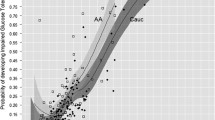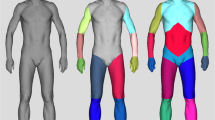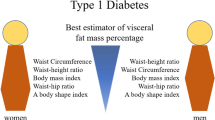Abstract
Background
In the context of increasing obesity prevalence, the relationship between large visceral adipose tissue (VAT) volumes and type 2 diabetes mellitus (T2DM) is unclear. In a clinical sample of severely obese women (mean body mass index [BMI], 46 kg/m2) with fasting normoglycemia (n = 40) or dysglycemia (impaired fasting glucose + diabetes; n = 20), we sought to determine the usefulness of anthropometric correlates of VAT and associations with dysglycemia.
Methods
VAT volume was estimated using multi-slice computer tomography; anthropometric surrogates included sagittal abdominal diameter (SAD), waist circumference (WC) and BMI. Insulin sensitivity (Si), and beta-cell dysfunction, measured by insulin secretion (AIRg) and the disposition index (DI), were determined by frequently sampled intravenous glucose tolerance test.
Results
Compared to fasting normoglycemic women, individuals with dysglycemia had greater VAT (P < 0.001) and SAD (P = 0.04), but BMI, total adiposity and Si were similar. VAT was inversely associated with AIRg and DI after controlling for ancestry, Si, and total adiposity (standardized beta, −0.32 and −0.34, both P < 0.05). In addition, SAD (beta = 0.41, P = 0.02) was found to be a better estimate of VAT volume than WC (beta = 0.32, P = 0.08) after controlling for covariates. Receiver operating characteristic analysis showed that VAT volume, followed by SAD, outperformed WC and BMI in identifying dysglycemic participants.
Conclusions
Increasing VAT is associated with beta-cell dysfunction and dysglycemia in very obese women. In the presence of severe obesity, SAD is a simple surrogate of VAT, and an indicator of glucose dysregulation.

Similar content being viewed by others
Abbreviations
- T2DM:
-
Type 2 diabetes mellitus
- VAT:
-
Visceral adipose tissue
- SAD:
-
Sagittal abdominal diameter
- WC:
-
Waist circumference
- BMI:
-
Body mass index
- Si:
-
Insulin sensitivity
- AIRg:
-
Acute insulin response to glucose
- DI:
-
Disposition index
- FSIGTT:
-
Frequently sampled intravenous glucose tolerance test
- FPG:
-
Fasting plasma glucose
- CT:
-
Computed tomography
- ROC:
-
Receiver operating curve
References
Flegal KM, Carroll MD, Ogden CL, et al. Prevalence and trends in obesity among US adults, 1999–2008. JAMA. 2010;303:235–41.
Knowler WC, Pettit DJ, Savage PJ, et al. Diabetes incidence in Pima Indians: contributions of obesity and parental diabetes. Am J Epidemiol. 1981;11:144–56.
Gregg EW, Cheng YJ, Narayan KMV, et al. The relative contribution of different levels of overweight and obesity to the increased prevalence of diabetes in the United States: 1976–2004. Prev Med. 2007;45:348–52.
Wang Y, Rimm EB, Stampfer MJ, et al. Comparison of abdominal adiposity and overall obesity in predicting risk of type 2 diabetes among men. Am J Clin Nutr. 2005;81:555–63.
Neeland IJ, Turer AT, Ayers CR, et al. Dysfunctional adiposity and risk of prediabetes and type 2 diabetes in obese adults. JAMA. 2012;308:1150–9.
Wagenknecht LE, Langefeld CD, Scherzinger AL, et al. Insulin sensitivity, insulin secretion, and abdominal fat. The insulin resistance atherosclerois study (IRAS) Family Study. Diabetes. 2003;52:2490–6.
Utzschneider KM, Carr DB, Hull RL, et al. Impact of intraabdominal fat and age on insulin sensitivity and β-cell function. Diabetes. 2004;53:2867–72.
Goodplaster BH, Kelley DE, Wing RR, et al. Effects of weight loss on regional fat distribution and insulin sensitivity in obesity. Diabetes. 1999;48:839–47.
Hanley AJG, Wagenknecht L, Norris JM, et al. Insulin resistance, beta-cell dysfunction and visceral adiposity as predictors of incident diabetes: the Insulin Resistance Atherosclerosis Study (IRAS) Familiy Study. Diabetologia. 2009;52:2079–86.
Pajunen P, Rissanen H, Laaksonen MA, et al. Sagittal abdominal diameter as a new predictor for incident diabetes. Diabetes Care. 2013;36:283–88.
Kahn SE, Prigeon RL, McCulloch DK, et al. Quantification of the relationship between insulin sensitivity and beta-cell function in human subjects. Evidence for a hyperbolic function. Diabetes. 1993;42:1663–72.
Cnop M, Landchild MJ, Vidal J, et al. The concurrent accumulation of intra-abdominal and subcutaneous fat explains the association between insulin resistance and plasma leptin compartments: distinct metabolic effects of two fat compartments. Diabetes. 2002;51:1005–15.
Lin E, Phillips LS, Ziegler TR, et al. Increases in adiponectin predict improved liver, but not peripheral, insulin sensitivity in severely obese women during weight loss. Diabetes. 2007;56:735–42.
Le K-A, Ventura EE, Fisher JQ, et al. Ethnic differences in pancreatic fat accumulation and its relationship with other fat depots and inflammatory markers. Diabetes Care. 2011;34:485–90.
Heni M, Machann J, Staiger H, et al. Pancreatic fat is negatively associated with insulin secretion in individuals with impaired fasting glucose and/or impaired glucose tolerance: a nuclear magnetic resonance study. Diabetes Metab Res Rev. 2010;26:200–5.
Kamel EG, McNeill G, Van Wijk MCW. Usefulness of anthropometry and DXA in predicting intra-abdominal fat in obese men and women. Obes Res. 2000;8:36–42.
Zamboni M, Turcato E, Armellini F, et al. Sagittal abdominal diameter as a practical predictor of visceral fat. Int J Obes. 1998;22:655–60.
Grundy SM, Cleeman JI, Daniels SR, et al. Diagnosis and management of the metabolic syndrome: an American Heart Association/National Heart, Lung, and Blood Institute Scientific Statement. Circulation. 2005;112:2735–52.
Lemieux S, Prud'homme D, Tremblay A, et al. Anthropometric correlates to changes in visceral adipose tissue over 7 years in women. Int J Obes. 1996;20:618–24.
Kamel EG, McNeill G, Van Wijk MCW. Change in intra-abdominal adipose tissue volume during weight loss in obese men and women: correlation between magnetic resonance imaging and anthropometric measurements. Int J Obes. 2000;24:607–13.
Drapeau V, Lemieux I, Richard D, et al. Waist circumference is useless to assess the prevalence on metabolic abnormalities in severely obese women. Obes Surg. 2007;17:905–9.
American Diabetes Association. Diagnosis and classification of diabetes mellitus. Diabetes Care. 2007;30:S42–7.
Bergman RN. Toward physiological understanding of glucose tolerance. Minimal-model approach. Diabetes. 1989;38:1512–27.
Haffner SM, Howard G, Mayer E, et al. Insulin sensitivity and acute insulin response in African Americans, Non-Hispanic Whites, and Hispanics with NIDDM: the Insulin Resistance Atherosclerosis Study. Diabetes. 1997;46:63–9.
Garcia-Fuentes E, Garcia-Almeida JM, Garcia-Arnes J, et al. Morbidly obese individuals with impaired fasting glucose have a specific pattern of insulin secretion and sensitivity: effect of weight loss after bariatric surgery. Obes Surg. 2006;16:1179–88.
Lin E, Liang Z, Frediani J, et al. Improvement in beta-cell function in patients with normal and hyperglycemia following Roux-en-Y gastric bypass surgery. Am J Physiol Endocrinol Metab. 2010;299:E706–12.
Gan SK, Kriketos AD, Poynten AM, et al. Insulin action, regional fat, and myocyte lipid: altered relationships with increased adiposity. Obes Res. 2003;11:1295–305.
Gastaldelli A, Sironi AM, Ciociaro D, et al. Visceral fat and beta-cell function in non-diabetic humans. Diabetologia. 2005;48:2090–6.
Macor C, Ruggeri A, Mazzenetto P, et al. Visceral adipose tissue impairs insulin secretion and insulin sensitivity but not energy expenditure in obesity. Metab Clin Exp. 1997;46:123–9.
Goran MI, Lane C, Toledo-Corral C, et al. Persistence of pre-diabetes in overweight and obese Hispanic children. Association with progressive insulin resistance, poor B-cell function, and increasing visceral fat. Diabetes. 2008;57:3007–12.
Maedler K, Oberholzer J, Bucher P, et al. Monounsaturated fatty acids prevent the deleterious effects of palmitate and high glucose on human pancreatic beta-cell turnover and function. Diabetes. 2003;52:726–33.
Carlsson LM, Peltonen M, Ahlin S, et al. Bariatric surgery and prevention of type 2 diabetes in Swedish obese subjects. N Engl J Med. 2012;367:695–704.
Nordhamn K, Sodergren E, Olsson E, et al. Reliability of antropometric measurements in overweight and lean subjects: consequences for correlations between anthropometrics and other variables. Int J Obes. 2000;24:652–7.
Sjostrom L, Lonn L, Chowdhury B, et al. The sagittal diameter is a valid marker of the visceral adipose tissue volume. In: Angel A, Anderson H, Bouchard B, Lau D, Leiter L, Mendelson R, editors. Progress in obesity research. Herts, United Kingdom: John Libbey & Company Ltd.; 1996. pp. 309–19.
Sampaio LR, Simoes EJ, Assis AMO, et al. Validity and reliability of the sagittal abdominal diameter as a predictor of visceral abdominal fat. Arq Bras Endocrinol Metab. 2007;51:980–6.
Yim JY, Kim D, Lim SH, et al. Sagittal abdominal diameter is a strong anthropometric measure of visceral adipose tissue in the Asian general population. Diabetes Care. 2010;33:2665–70.
Salmenniemi U, Ruotsalainen E, Vanttinen M, et al. High amount of visceral fat mass is associated with multiple metabolic changes in offspring of type 2 diabetic patients. Int J Obes. 2005;29:1464–70.
Nakata K, Choo J, Hopson MJS, et al. Stronger associations of sagittal abdominal diameter with atherogenic lipoprotein subfractions than waist circumference in middle-aged US white and Japanese men. Metab Clin Exp. 2010;59:1742–51.
Riserus U, Arnlov J, Brismar K, et al. Sagittal abdominal diameter is a strong anthropometric marker of insulin resistance and hyperproinsulinemia in obese men. Diabetes Care. 2004;27:2041–6.
Cowie CC, Rust KF, Byrd-Holt DD, et al. Prevalence of diabetes and high risk for diabetes using A1C criteria in the U.S. population in 1988–2006. Diabetes Care. 2010;33:562–8.
Muniyappa R, Lee S, Chen H, et al. Current approaches for assessing insulin sensitivity and resistance in vivo: advantages, limitations and appropriate usage. Am J Physiol Endocrinol Metab. 2008;294:E15–26.
Sjostrom L. A computer-tomography based multicomponent body composition technique and anthropometric predictions of lean body mass, total and subcutaneous adipose tissue. Int J Obes. 1991;1991:19–30.
Acknowledgements
This work was supported by National Institute of Health grants R03 DK067167 and R21 DK 075745 (to NGM), K24 RR023356 (to TRZ), DK066204 (to LSP), General Clinical Research Center Grant M01 RR00039 and the Atlanta Clinical and Translational Science Institute grant UL1 RR025008 and the Veterans’ Association HSR&D awards SHP 08–144 and IIR 07–138 (to LSP). This paper was submitted in part at the Scientific Sessions of the Society of American Gastrointestinal and Endoscopic Surgeons (SAGES) Meeting 2010. We thank all the study participants. Adeola T. Ayeni, MD, Emory University Department of Medicine, assisted with clinical research coordination of the study participants.
Conflict of interest
No conflict of interest
Disclaimer
The findings and conclusions in this article are those of the authors and do not necessarily reflect the official position of the Centers for Disease Control and Prevention.
Author information
Authors and Affiliations
Corresponding author
Rights and permissions
About this article
Cite this article
Gletsu-Miller, N., Kahn, H.S., Gasevic, D. et al. Sagittal Abdominal Diameter and Visceral Adiposity. OBES SURG 23, 874–881 (2013). https://doi.org/10.1007/s11695-013-0874-6
Published:
Issue Date:
DOI: https://doi.org/10.1007/s11695-013-0874-6




